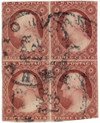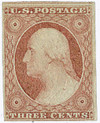
# 11A - 1853-55 3¢ George Washington, dull red, type II, imperf
U.S. #11A
Series of 1851-57 3¢ Washington
Type II
Earliest Known Use: October 6, 1851
Quantity issued: 340,000,000 (estimate)
Printed by: Toppan, Carpenter & Co.
Printing Method: Flat plate
Watermark: None
Perforation: Imperforate
Color: Dull red
While U.S. #11 and 11A were issued around the same time (1853-55), there is a notable difference between the two varieties. U.S. #11 (type I) has a single line frame while U.S. #11A (type II) features two lines in its frame. Both are dull red.
Types
Types or varieties occur when a stamp has differences that vary from the way it was originally intended to be printed. These differences occur when the design is being transferred to the plate for printing or when lines are re-cut.
The design is engraved on a die – a small, flat piece of steel. The design is copied to a transfer roll – a blank roll of steel. Several impressions or “reliefs” are made on the roll. The reliefs are transferred to the plate – a large, flat piece of steel from which the stamps are printed. When the design is being transferred to the roll or plate, differences can occur. A damaged plate or foreign matter causes differences. Lines re-cut on a worn plate can result in double lines.
The Series of 1851-57
In 1851, Congress reduced postal rates. These new rates practically eliminated distance as a factor and created a need for new denominations. The 1¢ stamp was used on all mail up to 3 ounces and on “drop letters” which were mailed to the same town. The single letter rate, based on a half ounce, was changed to 3¢ for mail not over a distance of 3,000 miles. Mail exceeding this distance was lowered to 6¢. In 1855, the rate for letters over 3,000 miles changed to 10¢.
Prepayment was still optional. If postage was paid by the addressee upon receipt, the rate was higher. Due to increased collect rates, the use of postage stamps was greatly stimulated. In 1855, pre-payment was made compulsory.
U.S. #11A
Series of 1851-57 3¢ Washington
Type II
Earliest Known Use: October 6, 1851
Quantity issued: 340,000,000 (estimate)
Printed by: Toppan, Carpenter & Co.
Printing Method: Flat plate
Watermark: None
Perforation: Imperforate
Color: Dull red
While U.S. #11 and 11A were issued around the same time (1853-55), there is a notable difference between the two varieties. U.S. #11 (type I) has a single line frame while U.S. #11A (type II) features two lines in its frame. Both are dull red.
Types
Types or varieties occur when a stamp has differences that vary from the way it was originally intended to be printed. These differences occur when the design is being transferred to the plate for printing or when lines are re-cut.
The design is engraved on a die – a small, flat piece of steel. The design is copied to a transfer roll – a blank roll of steel. Several impressions or “reliefs” are made on the roll. The reliefs are transferred to the plate – a large, flat piece of steel from which the stamps are printed. When the design is being transferred to the roll or plate, differences can occur. A damaged plate or foreign matter causes differences. Lines re-cut on a worn plate can result in double lines.
The Series of 1851-57
In 1851, Congress reduced postal rates. These new rates practically eliminated distance as a factor and created a need for new denominations. The 1¢ stamp was used on all mail up to 3 ounces and on “drop letters” which were mailed to the same town. The single letter rate, based on a half ounce, was changed to 3¢ for mail not over a distance of 3,000 miles. Mail exceeding this distance was lowered to 6¢. In 1855, the rate for letters over 3,000 miles changed to 10¢.
Prepayment was still optional. If postage was paid by the addressee upon receipt, the rate was higher. Due to increased collect rates, the use of postage stamps was greatly stimulated. In 1855, pre-payment was made compulsory.

















